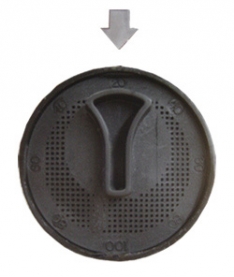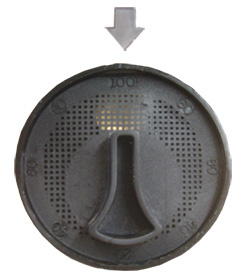FAQ - Composting
FAQ - Composting
How do I start the composter in winter?
The best way to keep the composter in operation is to bring waste to it regularly. That is how the decomposing organisms are continuously provided with nutrition, and the heat that they generate keeps the process running. Emptying a small amount of the mass and mixing a gruel made of water and Compoststarter in the surface layer may boost the decomposition process. Do not forget to apply bulking material. If the compost is at risk of freezing, you can heat it, for example, by putting a canister filled with hot water on top of or inside the compost mass. Freezing damages neither the compost mass nor the composter.
How and when do I mix the compost mass?
During operation the Composter hardly needs to be mixed at all. The air exchange system and the bulking material keep the compost mass airy. Do not mix the layers in different composting phases with each other. Only mix the top layer at intervals of a few weeks to a depth of about 30 cm. Press the Compostmixer into the compost mass from directly overhead and lift it back the same way.
What position should the air exchange valve of the Composter be in?
The adjustable valve in the front wall of the composter is for supplying the composter with the necessary air. At the start of composting, when the composter has not yet warmed up, adjust the valve to the position 20. The figure 20 is then at the upper edge of the adjustment disc, as shown in the “closed” picture. As the compost starts to warm up, adjust the air valve to a higher setting. You can turn the disc in either direction. When the temperature exceeds 30 ºC, the valve may be completely open. The figure 100 is then at the upper edge of the adjustment disc, as shown in the “open” picture. If the compost later starts cooling down, reduce the air exchange in the compost by adjusting the valve to a lower setting. In practice, the air exchange valve is normally kept in the “open” position in summer and in the “closed” position in winter.
|
Closed
|
Open
|
Why are there flies in the domestic waste compost, and how can they be exterminated?
The flies enter the compost, attracted by the odour of the waste. Most often the flies appear in the compost a few weeks after the process has been started, but before the composting has reached its normal level of activity. The flies normally disappear as the compost warms up. The flies are exterminated by turning over the surface layer, where they have laid their eggs, more deeply into the warmer part of compost. The fly maggots die at a temperature of about 43 ºC. The flies can be done away with using a pyrethrin-based insecticide (e.g. Bioruiskute S or Raid). These substances are not harmful to the composting process. These substances have no effect on the fly eggs or maggots, so the spraying must be repeated at intervals of a couple of days for at least a week. Long-term protection against the flies can be achieved by using a substance that is based on fly bacteria that is available at agricultural stores, for example, under the brand names 'DeLaval Larvicide Bio' and 'Stopper Bio'. This bacterium can survive in the compost for some time. It lives as a parasite in the fly maggot and kills it. The substance based on fly bacteria is effective only against young fly maggots, so the results of its use do not become visible until two to three weeks after application.
How do I ensure that the garden waste decomposes efficiently?
The garden waste decomposes more quickly in a composter than in an open compost. The composting is easiest if you have two composters. Then you will be able to allow the compost mass in one of the composters to mature completely, while you are filling the other composter. Start filling the composter by laying an airy bottom layer. When filling the composter, keep in mind the three-part rule: looseness, humidity and nutrients. Turn the compost mass over once or twice a year so as to bring the undecomposed substances from the edges of the compost to the warmest area in the middle. No composting will take place if the waste is too dry, so sprinkle the compost with water as required. If using the Biolan Garden Composter or the Biolan Stone Composter, less sprinkling is needed than when using an open compost. While composting garden waste, in particular autumn leaves, it pays to apply additional nutrients to speed up the composting process. Add Biolan Compoststarter or Biolan Natural Fertilizer granules into the mass to be composted. The garden composter freezes in winter, but the process resumes again as spring arrives. In a Garden Composter waste matures to compost soil in 1-2 years
Can all types of garden waste be composted?
It does not make sense to put every kind of garden waste into the compost. For example, some plant diseases and weeds might survive the composting process and be spread with the compost soil even to other parts of the garden.
You can put into an operating compost:
- apples with brown rot
- scabby potato tubers
- currant or sorbus leaves with blight
- plants damaged by leaf spot or grey mould
- parts or leaves of currants or gooseberries with maggots or aphides
- leaves damaged by gall mite
You can put into the compost either chopped or covered
- currant branches with gall mite
- strawberry bushes or runners with mite
- leaves or shoots with mildew
- potato tubers with blight or virosis
You must not put into the compost
- soil or tubers infested with potato-root eelworm
- rootstock or onion bulbs infested with cabbage root fly, onion fly or carrot fly
- roots or soil infested with clubroot
- onion bulbs with white rot
- potatoes with ring rot
- waste from root crop cellar in spring
- roots or seeds of couch grass or other perennial weeds
Is it possible to compost foodstuff waste in a garden composter?
A household waste composter that contains foodstuff must always be hermetically sealed against harmful animals, which means it has to be properly sealed against rodents and fitted with a tight cover. In addition, local waste disposal regulations require that a household waste composter, in particular in densely populated areas, be thermally insulated. In scarcely populated areas, where thermal insulation of the composter is not required, household waste can be composted in an uninsulated composter, such as the Biolan Garden Composter or the Biolan Stone Composter. A bottom basket of steel, to prevent rodents from entering the composter, is available as an option for the Biolan Garden Composter. The Biolan Stone Composter is hermetically sealed against harmful animals as standard. During the summer, in particular at a holiday home, a garden composter sealed against rodents is sufficient for composting household waste.
Is it reasonable to acquire the Composter 550 for the use of just one family?
The Biolan Composter 550 is intended for the use of several families, whereas the Biolan Composter 220 is sufficient for one family. If space allows, you can also put garden waste into both of these composters, but there is no point in acquiring a too-large thermal composter just for this purpose. Composting the waste proceeds more quickly in a correctly sized composter than in one that is too large.
Can meat or fish waste be composted?
Yes. A good rule of thumb is that any material of animate origin is suitable for the compost. Bones, however, do not usually decay quickly enough in a composter. Particular caution should be exercised with bird bones (which break down into sharp splinters), to ensure that dogs do not find them later on among the compost soil. It also pays to cover the leftovers of meat or fish particularly carefully with bulking material, so that they do not smell and attract flies.
Why is my composter completely inactive?
Most often the composter is inactive at the start when the amount of waste accumulated is not yet sufficient. As soon as the Biolan Composter is about half full, the decomposition process starts, and the temperature also starts to rise. This starting takes longer in winter than in summer. Another reason for the standstill is that the compost has reached its mature stage.
If nothing but eggshells, orange peels or other more slowly decomposing substances can be distinguished from the mass visible through the lower door, the compost soil is ready for emptying. Partial emptying often speeds up decomposition of the rest of the mass.
If the composter is too dry, the decomposition process slows down. The mass should be moist (but not wet). The lack of nutrients may also stop the process. This is common in garden composters with a large amount of dry plant waste. Household waste is usually very rich in nitrogen.



